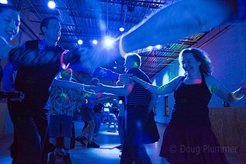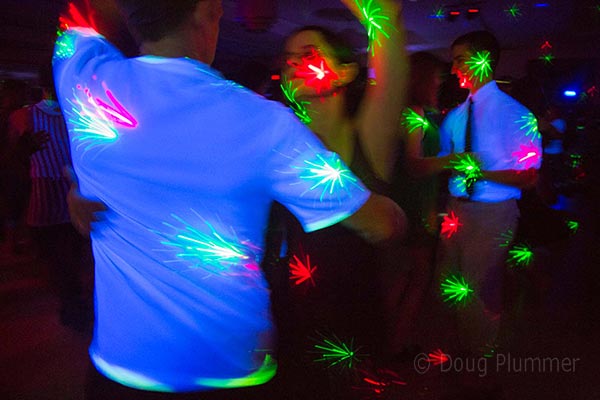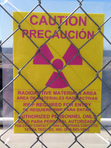 Doug Plummer. Contra Sonic, Glen Echo, MD, Oct. 2012.
Doug Plummer. Contra Sonic, Glen Echo, MD, Oct. 2012. "Actually, the idea came from my designer, Joanne Laterjung Kelly, who wanted to use my photos in her promo calendar," says Doug. "I wouldn't let her crop my images, and I said no. A year later I got her involved in making the calendar I wanted. I think a big part of the appeal of the calendar is how well it's designed."
I asked Doug about the photos he takes. "The motion thing is a leftover from my film days. You shoot at a slow shutter speed. The key, though, is to move the camera with the action. Pan with someone as they're moving across the line, so that they're sharper than the background, which gets blurred from the movement. If something in the frame looks kinda sharp, then the photo looks sharp." (N.B.: he has also posted a tutorial on the Kickstarter page entitled, "How To Take Dance Photos That Don't Suck -- The Video.")
He also adds, "Personality is bursting out all over on a dance floor, I don't have to try very hard [to find it]. I often hone in on one dancer in a line that seems to be exuding life and energy and love and all that, and kinda stalk them."
Further, the venue contributes to the photography as well: "Venue is personality. I always back up and make sure I get a hall shot with a wide lens. Sometimes it's the quality of light, and daytime dances in a hall with windows makes that quality come to the fore. I just shot in a gorgeous hall in Clarkdale, Arizona, windows on both sides, great backlight any direction you looked. Any photo in there is going to be imbued with the personality of that hall."
So, will the 2014 calendar include photos of crossover contras?
"Yes, I will have a month in the calendar showcasing the techno dance community. Shooting at a techno dance stretches the technology of image capture. It's dark, it's impossible to focus, and a flash would wreck the ambiance and annoy the dancers even more than it already does. I'm using high end pro gear, shooting at ISO 24,000, and it's hard. I love it."
He continues, "That the project is crowdsourced has changed my relationship to it, and to my sense of who the work is for. It's really a project of the dancers and the musicians and the organizers now. Kickstarter has fostered this wonderful sense of social indebtedness, that I have made a contract to fulfill this project that a community has entrusted me with. I feel closer to the dance community than ever before."
Doug continues, "When I started dancing and taking photos of dance, in the late 80's, it was a photographic problem for me to solve: how do I get a compelling image in a dynamic, difficult environment? This was with low ISO film, and it was a hard thing to do. That sensibility lingers--I'm after a great image, it just happens to be of this subject. But as I've become more deeply engaged in the dance community (thanks to the calendar, and social media), I feel more keenly that I'm a documentarian, and that I'm doing this for the community. The subject is becoming the important element now. "
June 13, 2013. Special thanks to him for answering my questions!


